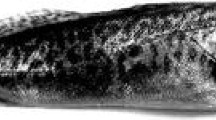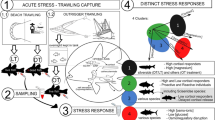Abstract
The cytosol and nuclear extract of gill tissue obtained from laboratory held Atlantic salmon,Salmo salar manifested saturable cortisol binding of high affinity and low capacity (cytosol: Ka = 0.198 ± 0.024 × 109/M, Nmax = 116.8 ± 20.8 fmol/mg protein; nuclear extract: Ka = 0.823 ± 0.057 × 107/M, Nmax = 1563 ± 330 fmol/mg protein; n = 4). The cytosol receptor activity displayed high steroid and tissue specificity and a single binding peak at 191,000 Da following gel permeation chromatography.
Atlantic salmon exposed for 3 or 8 months to waters from the Medway River (pH about 5.1), the Westfield River (pH about 4.8) and calcium carbonate treated Westfield River (pH about 5.6) showed no gill cytosol receptor activity. Cortisol receptor activity in the gill nuclear extracts from fish in limed Westfield River water in December (3 months) was less than half the activity in the fish treated with Medway River water (p < 0.05) although the plasma cortisol values were not different. In May (8 months), the plasma cortisol of fish in limed water was almost twice that of the fish held in acid Westfield River water (p = 0.058).
Similar content being viewed by others
References cited
Bradshaw, S.D. 1984. Seasonal variations in corticosteroid receptors within the nasal gland ofTiliqua rugosa. Gen. Comp. Endocrinol. 53: 475.
Boyd, P.A. and Spelsberg, T.C. 1979. Seasonal changes in the molecular species and nuclear binding of the chick oviduct progesterone receptor. Biochemistry 18: 3685–3690.
Chakraborti, P.K., Weisbart, M. and Chakraborti, A. 1987. The presence of corticosteroid receptor activity in the gills of the brook trout,Salvelinusfontinalis. Gen. Comp. Endocrinol. 66: 323–342.
Hoar, W.S. 1965. The endocrine system as a chemical link between the organism and its environment. Trans. Roy. Soc. Can., Ser.IV, 3: 175–200.
Ho-Kim, M.A. 1983. Determination of occupied cytoplasmic glucocorticoid receptor sites by an exchange assay in rat muscles. J. Steroid Biochem. 18: 179–184.
Nichols, D.J. and Weisbart, M. 1985. Cortisol dynamics during seawater adaptation of Atlantic salmonSalmo salar. Am. J. Physiol. 248: R651–R659.
Sandor, T., DiBattista, J.A. and Mehdi, A.Z. 1984. Glucocorticoid receptors in gill tissue of fish. Gen. Comp. Endocrinol. 53: 353–364.
Weisbart, M. and McGowan, L.K. 1984. Radioimmunoassay of cortisone in the adult Atlantic salmon,Salmo salar L. Gen. Comp. Endocrinol. 55: 429–436.
Wilkstrom, A.C., Bakke, O., Okret, S., Bronnegard, M. and Gustafsson, J.A. 1987. Intracellular localization of the glucocorticoid receptor: evidence for cytoplasmic and nuclear localization. Endocrinology 102: 1232–1242.
Author information
Authors and Affiliations
Rights and permissions
About this article
Cite this article
Weisbart, M., Chakraborti, P.K., Gottschall, F. et al. Effect of acid environments on cortisol and cortisol receptor activity in Atlantic salmon,Salmo salar . Fish Physiol Biochem 7, 267–272 (1989). https://doi.org/10.1007/BF00004716
Issue Date:
DOI: https://doi.org/10.1007/BF00004716




